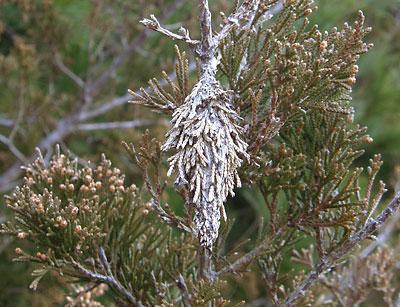Nature Notes: Watch for Bagworms

Just when you thought you had nature by the handle, here comes one of the most bizarre creatures yet, one you had no idea of and one that is found in less than a third of the field guides and other books dealing with insects and lepidopterans, in particular, moths.
It was two weeks ago when I was walking along the Long Beach parking lot road in Noyac when Vicki Bustamante pointed to something in the dune area between Long Beach Road and the parking lot. Not good, she said.
She was pointing toward a low eastern red cedar that appeared to be festooned with strange fruit like nothing I had ever witnessed. They looked like inverted pinecones. “Bagworms,” she said. (Vicki has a degree in horticulture and has worked in the local landscaping field for more than two and a half decades — she is familiar with insect pests.)
A week later I showed the arborist Bill Miller one that I had plucked on the way to the Long Island Botanical Society in Muttontown. “Bagworm,” he said without hesitation. He remembers seeing them in Ohio, where he grew up and went to college, but only once here, about two years ago, a large number of them in the junipers that grow along the south side of Bridgehampton’s Long Island Rail Road station. Vicki had remembered them from Maryland.
The books say that they are native to eastern America, but I don’t remember them when growing up on the North Fork or seeing them on the South Fork in the almost 32 years I’ve lived here since moving back to the East Coast from Oregon.
There is more than one kind of bagworm moth, but the one across the street from my house was the evergreen or juniper bagworm moth, Thyridopteryx ephemeraefomis. It has one of the most peculiar life cycles of all insects. As in the gypsy moth species, only males fly; females are sedentary. But while gypsy moth females are fully winged and legged, the female juniper bagworm has neither wings nor legs. She spends her entire short life in the pinecone-like cocoon, the “bag,” once she is a full-grown caterpillar and pupates in the early fall. She stays and dies before her eggs hatch in the spring and her little ones leave the bag.
This kind of adult life and the fact that the adult female has no appendages is not the most peculiar aspect of the species. As soon as the larvae crawl out of the bag, called the “case” in other species when it doesn’t resemble a fruit, they begin feeding. As they feed they become covered with bits of vegetation from their host foliage. They can feed on any number of hosts, but prefer junipers or arborvitae, where available. They crawl around becoming more and more camouflaged under a coat of needles and the sticky silk they manufacture and secrete. Eventually you don’t see the caterpillar at all, only the bag. In the case of this species, the bag hangs down in the fashion of a white pinecone.
A male and a female caterpillar will pupate, then mate inside the one bag, itself a very tricky process. After emergence from the pupae (inside the bag), mating takes place and only the male emerges from the bag, leaving behind the female and the eggs she lays.
On Monday many of the bags were already in shreds, an indication that the larvae were leaving them or that they were attacked by some kind of predator, perhaps birds. The ones I was studying were confined to the north side of Long Beach Road. Across the street there were many, many evergreens. Not a single one was infested.
Ever since the last cankerworm infestation of the middle part of the last decade and the very heavy gypsy moth caterpillar infestation of the turn of the century, I have been assiduously checking for both species. This fall and winter there were very few male cankerworm moths flying, and in the miles and miles of woods I have traveled in both Southampton and East Hampton I have come upon very few patches of gypsy moth eggs on the trunks and limbs of trees, but at the same time lots and lots of dead trees, particularly white oaks, reminders of those two back-to-back infestations.
Now, I wonder, are we in for an evergreen bagworm infestation? It only takes a few bags to start an epidemic. Keep an eye out.
